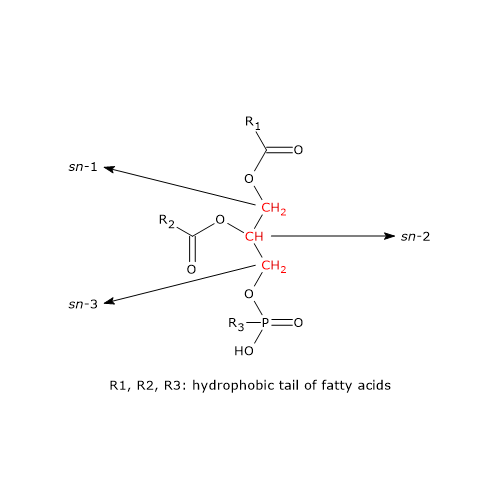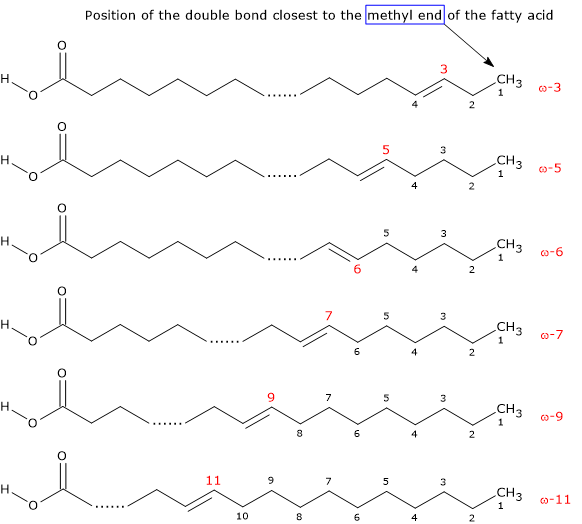Unsaturated fatty acids are fatty acids that contain one or more double/triple carbon-carbon bonds in the carbon chain. On this basis this class of lipids can be divided into:
- monounsaturated fatty acids (MUFAs), if only one double bond is present;
- polyunsaturated fatty acids (PUFAs), if at least two double bonds are present;
- acetylenic fatty acids, if one or more triple bonds are present.
Contents
Cis and trans double bonds
Carbon-carbon double bonds are the most common multiple bonds present in unsaturated fatty acids. They have a planar conformation; therefore, they can be considered as plans from whose opposite sides carbon skeleton attaches and continues.
If the entry and the exit of the chain occurs on the same side of the plan, double bond is in cis configuration.
Conversely, when the chain enters and exits on opposite sides of the plan, double bond is in trans configuration, which is found in trans fatty acids.
In nature, cis configuration is the most common one for unsaturated fatty acids.
Generally, unsaturated fatty acids into membranes are confined to the sn-2 position of phospholipids, and have 18 to 20 carbon atoms. In the sn-1 position, saturated fatty acids with a carbon atom number between 16 and 18 are most commonly found..

In triacylglycerols, MUFAs and long chain saturated fatty acids tend to be in sn-1 and sn-3 positions, whereas PUFAs in sn-2 position.
Note: sn = stereospecific numbering.
Classification
Monounsaturated fatty acids
Although more than 100 MUFAs have been identified in nature, most of these are very rare.
Oleic acid, a long chain monounsaturated fatty acid, is widely distributed and abundant in nature. In fact, it is present in only a few fats with values lower than 10 percent. The highest content is found in extra-virgin olive oil, about 70 g/100 g edible portion.
In human diet, unsaturated fatty acids are almost exclusively oleic acid. However, if fish and/or rapeseed oil consumption play a large role in one’s diet, there are present moderate amounts of 20 and 22 C monounsaturated fatty acids.
Polyunsaturated fatty acids
Depending on the relative positions of the double bonds, PUFAs can be divided in three categories:
- conjugated, if double-bonds alternate with single bonds (–C=C–C=C–);
- unconjugated, if the double bonds are separated by carbon atoms bonded with single bonds, usually in a methylene-interrupted arrangement (–C=C–C–C=C–);
- the third group, in which double bonds are not entirely in a methylene-interrupted arrangement (present in certain microorganisms, marine lipids and some seed oils).
Also if conjugated dienes exist, they don’t occur extensively. Examples are sorbic acid (2,4-hexadienoic acid) and trans-2-cis-4-decadienoic acid, a known flavor component present in Williams pears or Bartlett pears in the U.S. and Canada.
Among conjugated PUFAs, the most common ones are trienes, but they are present in small amounts in animal fats and are abundant in only a few seed oils.
The omega or n designation system
The most important PUFAs in terms of extent of occurrence are the unconjugated and methylene-interrupted ones.
They are subdivided into families, depending on the position of the double bond closest to the methyl side, numbered 1, of the fatty acid molecule and are categorized in 12 omega families. Letter n may be used in place of letter ω.
This classification system applies also to monounsaturated fatty acids; for example, oleic acid is an omega-9 fatty acid.

In human nutrition, the most important families are omega-3, omega-6, and omega-9. If we also consider the omega-7 family, then almost all unsaturated fatty acids consumed in a typical diet are included.
The omega designation system groups unsaturated fatty acids into families depending on the capability to be converted/interconverted to each other.
It should be emphasized, however, that interconversion occurs only within the same family, not between families.
This does not mean that all the fatty acids of a ω-family have the same physiological functions. In fact it appear clearly that each fatty acid has its own role in nutrition; examples are:
- within omega-6 polyunsaturated fatty acids, dihomo-gamma-linolenic acid and arachidonic acid, that give rise prostaglandins, a type of eicosanoids, with different physiological effects;
- between omega-6 and omega-3 polyunsaturated fatty acids, arachidonic acid and eicosapentaenoic acid (EPA), that differ only by an additional double bond in EPA, have a metabolic antagonistic relationship.
It should be noted that linoleic acid, an omega-6 fatty acid, and alpha-linolenic acid, an omega-3 fatty acid, are essential fatty acids for humans.
It is thought that polyunsaturated fatty acids exert their physiologic effects through a variety of mechanisms, ranging from modulating membrane structure to acting as precursors for signal molecules, e.g. eicosanoids.
Polyunsaturated fatty acids and human diet
In human diet, the consumed PUFAs are almost exclusively linoleic acid and alpha-linolenic acid. In the typical Western diet they account for more than 95 percent of PUFA taken up, unless one is eating much fish, in which case there are good amounts of EPA and docosahexaenoic acid (DHA), both omega-3 polyunsaturated fatty acids.
For healthy people, with no documented cardiovascular diseases, American Heart Association recommends eating one serving of oily fish at least twice a week, plus oils rich in alpha-linolenic acid. In the case of patients with documented cardiovascular diseases, the recommendations are 1 g/day of EPA plus DHA, and for those with hypertriglyceridemia, 2 to 4 g/day of EPA plus DHA are recommended.
Linoleic acid, with oleic acid and palmitic acid are the three most abundant fatty acids in triacylglycerols of plasma lipoproteins and fat tissue.
For a list of the most common saturated and unsaturated fatty acids, see the page List of fatty acids.
Acetylenic fatty acids
They have a linear carbon chain characterized by the presence of one or more triple carbon-carbon bonds.
They are rarely found in naturally occurring lipids (fats and oils), being present only in some mosses and in few seed oils.
References
- Akoh C.C. and Min D.B. “Food lipids: chemistry, nutrition, and biotechnology” 3th ed. 2008
- Bender D.A. “Benders’ dictionary of nutrition and food technology”. 2006, 8th Edition. Woodhead Publishing. Oxford
- Burr G. and Burr M. A new deficiency disease produced by the rigid exclusion of fat from the diet. J Biol Chem 1929;82:345-367. doi:10.1016/S0021-9258(20)78281-5
- Chow Ching K. “Fatty acids in foods and their health implication” 3th ed. 2008
- Rosenthal M.D., Glew R.H. Mediacal biochemistry. Human metabolism in health and disease. John Wiley & Sons, Inc., Publication, 2009
- Stipanuk M.H., Caudill M.A. Biochemical, physiological, and molecular aspects of human nutrition. 3rd Edition. Elsevier health sciences, 2012